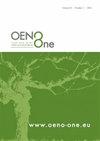Impact of mannoproteins from different yeast species on wine properties
IF 2.2
3区 农林科学
Q3 FOOD SCIENCE & TECHNOLOGY
引用次数: 0
Abstract
The extent to which the addition of extracted mannoproteins (MPs) improve wine properties such as mouthfeel, clarity and colour stability is a controversial topic, and conflicting results have been reported. One possible explanation for this is the diversity that exists between MPs, a prevalent cause for which is their yeast strain of origin. However, although wine yeast species other than Saccharomyces cerevisiae possibly present an untapped source of MPs, their influence on wine as extracted additives is still ill-characterised. This study sought to compare the impact of MPs extracted and purified from different yeast species, named Saccharomyces boulardii, Saccharomyces cerevisiae, Metschnikowia fructicola and Torulaspora delbrueckii, as well as a commercial control, on wine. MPs were applied to a red and a white wine at three different concentrations, and BSA-reactive tannins, polymeric pigments, colour characteristics, browning potential and protein haze-forming potential were measured over the course of six months. The most notable differences were observed for the commercial MP, which achieved lower BSA-reactive tannins, increased polymeric pigments and a greater reduction of browning potential. This could be due to the difference in preparation procedures compared to the MPs extracted and purified for this study, possibly leading to variations in the commercial MPs’ structure and composition. However, some differences were also evident between species, with M. fructicola treatments achieving a 20 % reduction in browning compared to ~10 % for the other purified MPs and significantly increased colour intensity of red wine treated with low concentrations of T. delbrueckii. This study highlights alternative yeast species as a potential source of MPs with diverse benefits to wine and the need for further investigation into their diversity and properties to promote their eventual exploitation.不同酵母种类的甘露蛋白对葡萄酒特性的影响
添加提取的甘露蛋白(MPs)在多大程度上改善了葡萄酒的口感、清晰度和颜色稳定性等特性,这是一个有争议的话题,报道了相互矛盾的结果。一种可能的解释是MPs之间存在多样性,一个普遍的原因是它们的酵母菌株的起源。然而,尽管除酿酒酵母外的葡萄酒酵母菌可能存在未开发的MPs来源,但它们作为提取添加剂对葡萄酒的影响仍然不明确。本研究试图比较从不同酵母菌中提取和纯化的MPs对葡萄酒的影响,这些酵母菌分别被命名为博拉氏酵母菌、酿酒酵母菌、果霉菌和德布鲁基Torulaspora delbrueckii,以及商业对照。将MPs应用于三种不同浓度的红葡萄酒和白葡萄酒中,并在六个月的时间里测量bsa -活性单宁,聚合色素,颜色特征,褐变电位和蛋白质烟雾形成电位。最显著的差异是在商业MP中观察到的,它获得了较低的bsa活性单宁,增加了聚合色素和更大程度上降低了褐变电位。这可能是由于制备过程与本研究中提取和纯化的MPs不同,可能导致商业MPs的结构和组成发生变化。然而,物种之间的差异也很明显,与其他纯化MPs相比,果霉处理的褐变减少了20%,而其他纯化MPs的褐变减少了10%,并且低浓度的delbrueckii处理的红葡萄酒显着增加了颜色强度。本研究强调了替代酵母物种作为MPs的潜在来源,对葡萄酒有多种好处,需要进一步研究它们的多样性和特性,以促进它们的最终开发。
本文章由计算机程序翻译,如有差异,请以英文原文为准。
求助全文
约1分钟内获得全文
求助全文
来源期刊

OENO One
Agricultural and Biological Sciences-Food Science
CiteScore
4.40
自引率
13.80%
发文量
85
审稿时长
13 weeks
期刊介绍:
OENO One is a peer-reviewed journal that publishes original research, reviews, mini-reviews, short communications, perspectives and spotlights in the areas of viticulture, grapevine physiology, genomics and genetics, oenology, winemaking technology and processes, wine chemistry and quality, analytical chemistry, microbiology, sensory and consumer sciences, safety and health. OENO One belongs to the International Viticulture and Enology Society - IVES, an academic association dedicated to viticulture and enology.
 求助内容:
求助内容: 应助结果提醒方式:
应助结果提醒方式:


